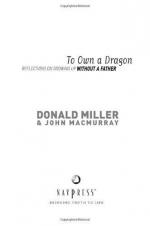
|
| Name: _________________________ | Period: ___________________ |
This test consists of 5 multiple choice questions, 5 short answer questions, and 10 short essay questions.
Multiple Choice Questions
1. Prior to accepting God as a father, Miller describes his journey as ________.
(a) Hopeless.
(b) Aimless.
(c) Intentional.
(d) Purposeful.
2. According to the author, what percentage of male prisoners grew up without a father?
(a) 85%.
(b) 95%.
(c) 75%.
(d) 25%.
3. Writing this book appears to have been what type of experience for the author?
(a) Cathartic.
(b) Difficult.
(c) Selfish.
(d) Boring.
4. Miller asks for what from the reader?
(a) Sympathy.
(b) Open mindedness.
(c) Commitment.
(d) Patience.
5. How does the ability to accept a spiritual connection between God and fathers help Miller?
(a) It helps Miller to feel accepted.
(b) It allows Miller to experience a sense of belonging.
(c) It has not impact on Miller.
(d) It allows Miller to find a father.
Short Answer Questions
1. Why is Miller particularly upset with older men?
2. In Chapter 1, Miller discusses several attempts to find a father figure during what part of his life?
3. How do these stories from Miller's childhood help the reader understand Miller, the author?
4. What tasks must elephants accomplish when they reach puberty?
5. What does Miller use as an analogy for God's love and father-son love?
Short Essay Questions
1. The author introduces the concept of a spiritual journey in Chapter 4. Describe Miller's reaction to this spiritual journey.
2. In Chapter 3, Miller admits to being resentful towards authority figures. To whom is he referring and why?
3. What does Miller learn about family from living with the MacMurray family?
4. In Chapter 6, Authority, Miller uses a metaphor of airline pilots warning each other about weather conditions. What point is Miller illustrating with this story?
5. In Chapter 5, what does Miller describe as crucial tasks of families?
6. In Chapter 1, Miller describes several events and activities in which he attempts to interact with adult men. Most of these experiences do not appear to have been successful. In addition to camping, making a derby car, and playing with a remote-controlled airplane, what other "manly man" activities may Miller have missed because he did not have a father?
7. What role does church play in Miller's life and why does he join a church in Boring, Oregon?
8. What kind of experience did writing this book provide the author?
9. In Chapter 5, Miller begins to identify the positive and negative characteristics of God's love. What are these characteristics?
10. Miller presents statistics about the percentage of males in prison raised without a father. He suggests there is a connection between these statistics and the orphaned elephants. What is this connection?
|
This section contains 1,034 words (approx. 4 pages at 300 words per page) |

|




